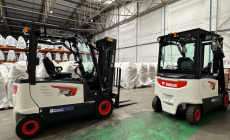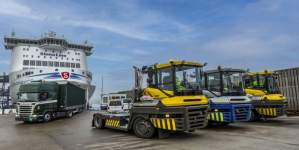-
Women Leading the Way in the UK Material Handling Industry - December 12, 2025
-
LiftEx 2025 live from Liverpool - December 11, 2025
-
DATA ANALYSIS – THE FOUNDATION OF EVERY PEAK SEASON - December 5, 2025
-
Creative education specialists Creative Hut give 3PL full marks for onboarding excellence - December 5, 2025
-
Unlimited Industries raises $12M to build the AI construction company that will power America’s future - December 4, 2025
-
Scottish Leather Group gets full-support solution from Rushlift - December 4, 2025
-
Etaily lands strategic investment from Japan’s SMBC – bringing total funding to $24M for Social Commerce enablement platform - December 4, 2025
-
Winners lift their LEEA Awards and raise the industry - December 4, 2025
-
Prism eLogistics and Brand Angels Partnership Gives Brands the Full Package - December 3, 2025
-
New data shows Tesla in danger of losing its way as European consideration to buy Chinese cars jumps 16% in 12 months - December 3, 2025
7 ways to use a TMS to add flexibility in a multichannel environment
The location of most middle-class consumers is shifting, and retailers are developing channels to adapt. Increased competition and the quest for growth are driving the need to react quickly to changing market demands. These drivers are especially strong in multichannel supply chains, where the pressure to serve different delivery channels leaves little room for error. Omnichannel aims to deliver first-rate buying experiences to consumers, maintaining a high service standards for fulfillment, all while continuing to meet consumers’ rising expectations—even as shipment volumes increase.
TMS technology can play a key role in helping companies develop new multichannel capabilities and improve existing ones. In every case, efficient freight transportation melds the channels into a seamless service offering. Transportation management system (TMS) technology enables shippers to more effectively manage freight movements in the complex multichannel environment. Here are seven ways to use a TMS to bring agility, flexibility and success to your company or organization:
1. Form a project management office. In highly competitive markets, a TMS solution can include a team that provides dedicated focus, whether for a short or extended time. This team can drive consistency in process transformation and deployment.
2. Conduct high-speed processing. The quick processing times of TMS solutions support rapid data capture and responsive service optimization—capabilities that are critically important when meeting the needs of online customers who don’t want to wait for their purchase to arrive.
3. Make fast, agnostic transportation selection. A TMS that houses all of the customer’s freight information can quickly select the most cost-effective routes and logistics service provider to meet each order’s requirements.
4. Optimize orders. A multichannel-oriented TMS specifies how loads are to be shipped, rather than leaving it up to the supplier to manage the logistics of deliveries. This proactive approach allows the supplier to concentrate on meeting their delivery deadlines while affording them greater control over the freight network.
5. Harness analytical power. Aggregating loads at the order level requires sophisticated TMS analytics, as well as users who know how to get the most from the technology in service of the freight network.
6. See the supply chain. In multichannel supply chains, the shipper must know the status of both inbound and outbound shipments, as well as returns, since freight is moving between multiple nodes and across channels. However, the level of visibility must be attuned to the needs of each individual supply chain.
7. Manage events and on time deliveries. With the sheer number of events and the complexity of information flows in multichannel supply chains, shippers must be able to link milestones to automated activity tracking and quickly flag exceptions.
Even the most sophisticated, flexible TMS solution needs the skills of expert users to be fully effective. This is especially important in complex multichannel environments, when a TMS is supporting many types of freight transportation networks across multiple industries. In this supporting role, a TMS solution can be tailored to each network, and it can provide essential features that are shared by different multichannel operations. The shipper can choose the best mix of options, depending on what the business considers most important to gaining a competitive advantage.
One truth is certain: Today’s multichannel supply chains have reached a new level of complexity, driven largely by the dramatic growth of e-commerce and the success of virtual market leaders
Keeping pace with constantly changing multichannel models can be a formidable challenge. For instance, in a country as vast as China, a new product can suddenly add millions of transactions to a supply chain operation. Remember that a TMS tracks each container’s inventory so demand planners can support order volumes across channels and provides robust, automated system for flagging exceptions.Comment by Shane Manning, Director EMEA of TMC , a division of CH Robinson

































